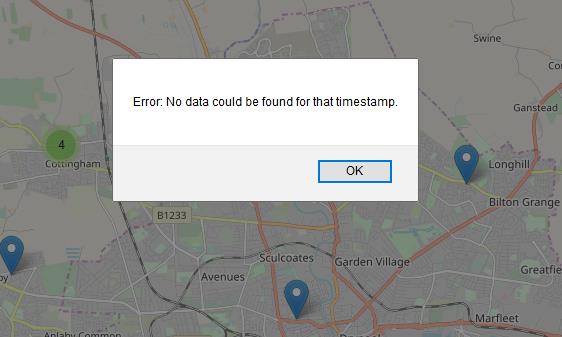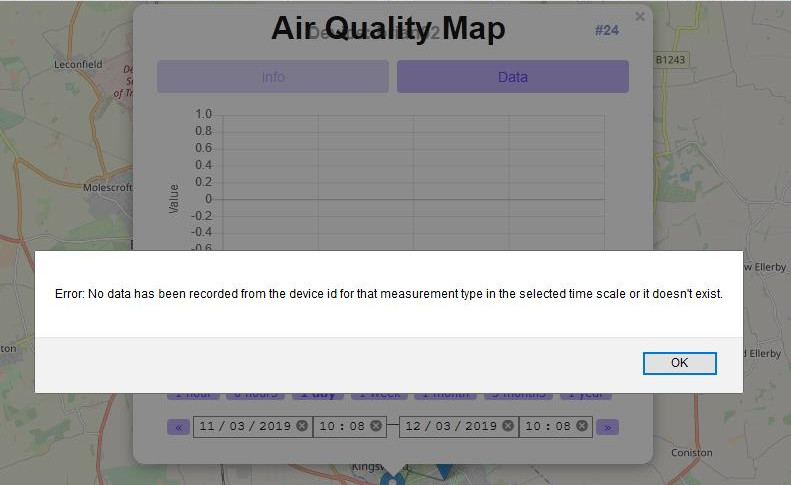9.5 KiB
Installing the Air Quality Map on a Raspberry Pi
These instructions will enable you to install the Connected Humber Air Quality Map API/APP on a Raspberry Pi for the purposes of testing changes.
These instructions assume you will want to use the, recommended, NGINX web server and the MariaDB (MySQL) for the database.
You will also install a small python program (dbLoader.py) to listen to either the Connected Humber MQTT broker or a local Mosquitto broker which you can publish test messages to.
CAVEAT: At this time, this system is undergoing constant change and this document may fall behind, especially the Air Quality Web section which is being worked on and updated frequently.
Hardware Required
- A Raspberry Pi 3/3+ would be great as they have on-board WiFi. Possibly this software could also be installed on any other Linux based hardware and earlier RPi (though the 3+ is faster)
- Bluetooth Keyboard, mouse and an HDMI monitor you can find out what IP address your Pi has been given. Thereafter you could use a program called Putty to remote login to a terminal window
- An internet connection - the faster the better
Database
For offline testing you will need to install MariaDB (MySQL) and import a mysqldump of the database. So you should get a copy of the dump before you start. Note that a mysqldump will get bigger as time proceeds.
If you are not bothered about testing with historic data you could use a dump without data but you will need to add some entries to the devices, device_types and reading_value_types tables before you can start loading records from the MQTT broker.
Installation
Assuming your Pi has a mouse, keyboard and monitor...
RPi Stretch
- You should begin by doing a clean install of Raspbian Stretch on an SD card.
- make a note of the login password you set
- make a note of the IP address (192.168.1.80 in my case)
- If the mouse is slow to respond add the following to the end of the
/boot/cmdline.txtfile whilst Raspbian updates.
usbhid.mousepoll=0
PHP 7.x
You need at least php v7.1. if php -v shows a lower version then you need to upgrade it as follows:-
Step 1
sudo nano /etc/apt/sources.list.d/10-buster.list
add this line:-
deb http://mirrordirector.raspbian.org/raspbian/ buster main contrib non-free rpi
Step 2
sudo nano /etc/apt/preferences.d/10-buster
Add the following lines:
Package: *
Pin: release n=stretch
Pin-Priority: 900
Package: *
Pin: release n=buster
Pin-Priority: 750
Step 3
sudo apt update
NOTE: You may need to change the version number in the following command as time goes by:-
sudo apt-get install -t buster php7.3 php7.3-curl php7.3-gd php7.3-fpm php7.3-cli php7.3-opcache php7.3-mbstring php7.3-xml php7.3-zip php7.3-mysqlphp -vshould show you have installed php version 7.3, or later, ok
Web Server
Step 1
sudo apt install nginx
You should now be able to use the browser and access localhost to get the Nginx welcome screen.
Configure nginx for php:
cd /etc/nginx/sites-availablesudo nano default
Uncomment the PHP section so it looks like this:
# pass PHP scripts to FastCGI server
#
location ~\.php$ {
include snippets/fastcgi-php.conf;
# With php-fpm (or other unix sockets):
fastcgi\_pass unix:/run/php/php7.3-fpm.sock;
# With php-cgi (or other tcp sockets):
#fastcgi\_pass 127.0.0.1:9000;
}
We are going to put the Air Quality Web code into the localhost html folder (/var/www/html). If you know how to setup a virtual site using nginx then you should do so now and use the root of that server (something like /var/www/mysite.com or /srv/mysite.com, maybe)
For systems which may be accessed from the internet you need to lock down access to config info as follows:
In Nginx:
nano /etc/nginx/nginx.conf
Put this inside the "server { }" block:
location ^~ **/path/to/data/directory** {
deny all;
}
NOTE: /path/to/data/directory might be /var/www/html/data if you are not using a virtual website
In Apache:
Create a file called .htaccess inside the data/ directory with this content
Require all denied
Finally, restart the web server
- Nginx:
sudo systemctl restart nginx - Apache:
sudo systemctl restart apache2
Database
You will need an SQL dump of the database ready before you do this. You could put this on a USB drive or install an ftp server/client (not covered here)
sudo apt install mariadb-client mariadb-server
The password for sudo access to mysql is the same as the pi login password from earlier.
To make life easier for now, upload the database and add a user with full access rights. This is ok on a test machine but you would secure the database against attacks on the live machine. You would fully secure a public system.
sudo mysql
>create database aq_db;
>use aq_db;
>source <your sqldump file>
>grant all privileges on aq_db.* to username@localhost identified by "password"
username and password will be your dbUser and dbPassword which you need to access the database and place in the settings files for dbLoader.py and the Air Quality Map.
Update Node & NPM
echo "deb https://apt.starbeamrainbowlabs.com/ ./ # apt.starbeamrainbowlabs.com" | sudo tee /etc/apt/sources.list.d/sbrl.list
sudo curl -sSL https://apt.starbeamrainbowlabs.com/aptosaurus.asc -o /etc/apt/trusted.gpg.d/sbrl-aptosaurus.asc;
sudo apt update
sudo apt install nodejs-sbrl
Air Quality Web
Finally, we are going to build the AQW software in a folder then copy the files into /var/www/html. You need to be logged in as a regular user (pi is fine)
cd $HOME
git clone https://github.com/ConnectedHumber/Air-Quality-Web
cd Air-Quality-Web
./build setup setup-dev
The following warning can be ignored:
leaflet.marckercluster1.4.1 requires a peer of leaflet@~1.3.1 but none installed
Now run these commands
NODE_ENV=production ./build client
Edit the file data/settings.toml and add the database username and password.
If your database is on a remote machine edit settings.default.toml find the line host="127.0.0.1" and set the IP to your database machine.
You will need to ensure your database server allows remote access with a suitably secure grant command.
Copy the files to the web site root:
sudo cp -r * /var/www/html
sudo chown -R www-data:www-data /var/www/html/*
Now point your browser at localhost/app and the Air-Quality-Map page should display.
Adding New Devices
Currently this is a manual task.
Devices not listed in the devices table are ignored - you will see messages in the dbLoader log file which says something like
processJob(nnn): unresolved device_id. Payload skipped'
Keeping the local database up to date
The database is updated with a python program which subscribers to our broker and processes the messages it received.
You need to run dbLoader.py on your local machine. You can find it here:-
https://github.com/ConnectedHumber/MQTT/tree/master/Subscriber
You need BOTH dbLoader.py and settings.py.
Edit settings.py and put in the correct username/password for the Connected Humber MQTT broker and your local database.
Logfile rotation
Create a file in /etc/logrotate.d:
sudo nano /etc/logrotate.d/dbLoader
Add the following (if you changed the logFile name in settings.py change it here too).
/var/log/aq_db.log {
missingok
notifyempty
size 50k
daily
compress
maxage 30
rotate 10
create 0644 root root
copytruncate
}
Adding dbLoader as a service
This will allow you to control the dbLoader
sudo nano /etc/system.d/system/dbloader.service
Add these lines:
[Unit]
Description=dbLoader service
After=mysqld.service
StartLimitIntervalSec=0
[Service]
Type=simple
Restart=always
RestartSec=1
User=root
ExecStart=/usr/bin/env python /home/pi/aq_db/dbLoader.py
[Install]
WantedBy=multi-user.target
Now you can control dbLoader with commands like:
sudo systemctl start dbLoader
sudo systemctl status dbLoader
sudo systemctl stop dbLoader
In order to have dbLoader restart on boot use this command:
sudo systemctl enable dbLoader
Note that you will be prompted for the User's password.
Database Schema Changes
Currently it is a manual task to add extra columns/tables. If there are any changes it is simpler to request a new SQL dump of the existing database, drop the existing aq_db tables (not the database) then import the SQL dump with the source command as was done earlier.
Local MQTT broker (optional)
You can install Mosquitto as a local MQTT broker then publish test messages to it. If you configure dbLoader.py to listen to your test broker it will then add you data to your local database.
sudo apt-get update
sudo apt-get install mosquito
The mosquito service will run automatically.
You can add password/username to the broker (if you need to). The instructions here will help you do that.
http://www.steves-internet-guide.com/mqtt-username-password-example/
Finally
When you fire up the map you will, inevitably, get this message:
It simply means the database needs fresh data.
When you click on a blue marker you may get this:
When the dialog displays it chooses a recent timescale. The messages just means the device hasn't got any recent data (it could be offline). Select a different time frame and you should get something like this:


